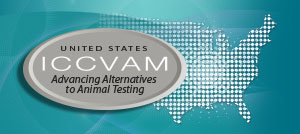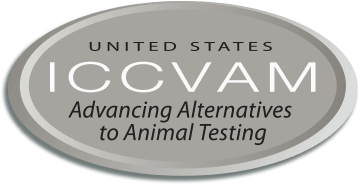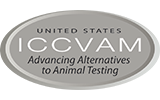Efforts by individual countries to develop NAMs will have little impact without international adoption of the new methods. To advance international adoption, ICCVAM and its member agencies interact frequently with international partners to facilitate harmonization and regulatory acceptance.
International Interactions
Contributions to OECD Activities
ICCVAM member agencies participate in the development and review of chemical testing guidelines issued by the OECD Test Guidelines Programme. OECD test guidelines are used by government, industry, and independent laboratories of the 38 OECD member countries to assess chemical safety. The U.S. National Coordinators for the OECD Test Guidelines Programme, who are members of ICCVAM, solicit and collate U.S. comments on draft test guidelines and other documents of the Test Guidelines Programme. The National Coordinators represent the United States at the annual meeting of the Working Group of National Coordinators and in other test guideline development activities. One or more ICCVAM subject matter experts may join the U.S. National Coordinators at this meeting.
In 2020 and 2021, ICCVAM agencies commented on draft OECD documents through the U.S. National Coordinators. ICCVAM members and/or NICEATM staff also supported the Test Guidelines Programme during 2020 and 2021 by:
- Contributing to a proposal to update OECD Test Guideline 496 for in vitro test methods to identify eye irritants to add the OptiSafe test method to the guideline.
- Serving on an expert group developing a guideline for defined approaches for skin sensitization. This group supported the development of Guideline 497, Defined Approaches for Skin Sensitisation, issued in 2021. Guideline 497 is the first internationally harmonized guideline to describe a non-animal defined approach that can be used to replace an animal test to identify skin sensitizers. NICEATM and ICCVAM scientists are currently contributing to two proposals to update Guideline 497 to include new information sources for existing defined approaches, and new defined approaches for quantitative risk assessment.
- Participating in a group developing a Case Study on the Use of an IATA for Identifying Androgen Receptor Active Chemicals, which has been submitted to the OECD Working Party on Hazard Assessment.
- Contributing to a retrospective review of available data and information to support an OECD test guideline for a human reconstructed epidermis model for phototoxicity testing. Test Guideline 498, In Vitro Phototoxicity - Reconstructed Human Epidermis Phototoxicity Test Method, was adopted in June 2021.
- Serving on the Validation Management Group – Non-animal, which focuses on evaluation of new methods for identifying endocrine disruptors.
- Serving on an expert group considering test batteries for developmental neurotoxicity.
Participation in the International Cooperation on Alternative Test Methods
The International Cooperation on Alternative Test Methods (ICATM) was created to foster dialog among national validation organizations. This dialog facilitates international cooperation in the critical areas of validation studies, independent peer review, and development of harmonized recommendations. ICATM includes member organizations from the European Union, United States, Japan, Canada, and South Korea. Brazil and China have been participating in ICATM since 2015 as observers.
ICATM Participant Organizations
- ICCVAM is an interagency committee of the U.S. government that coordinates technical reviews of alternative test methods and cross-agency activities relating to validation, acceptance, and harmonization of test methods. NICEATM administers ICCVAM and provides scientific support for its activities.
- EURL ECVAM (European Union Reference Laboratory for Alternatives to Animal Testing) is a unit within the Institute of Health and Consumer Protection in the European Union’s Joint Research Centre. EURL ECVAM coordinates the validation of alternative test methods in the European Union.
- JaCVAM (Japanese Center for the Validation of Alternative Methods) coordinates the evaluation of alternative test methods for the Japanese National Institute of Health Sciences, its parent organization.
- Health Canada’s Environmental Health Science and Research Bureau coordinates the evaluation of alternative test methods in Canada. The Canadian Centre for Alternatives to Animal Methods and its subsidiary, the Canadian Centre for the Validation of Alternative Methods, participate as partners with Health Canada in ICATM activities.
- KoCVAM (Korean Center for the Validation of Alternative Methods) is part of the National Institute of Food and Drug Safety Evaluation of the South Korean Food and Drug Administration.
- BraCVAM (Brazilian Center for the Validation of Alternative Methods) functions as the focal point within Brazil to identify or receive requests for test method validation. It works to implement appropriate validation studies with the National Network of Alternative Methods to the Use of Animals within the Brazilian Ministry of Science, Technology, Innovations, and Communications.
An ICATM coordination meeting was hosted virtually by JaCVAM in October 2020. Representatives from the United States, European Union, Canada, Japan, South Korea, and Taiwan presented updates on recent activities. Discussion topics included.
- The concept of standards and approaches to validation that could replace multi-laboratory studies.
- Activities to address European recommendations on use of non-animal derived antibodies.
- Development of detailed review papers and integrated approaches to testing and assessment.
- Human-relevant approaches to assessing the eye irritation potential of agrochemical formulations.
In 2020, EURL ECVAM issued recommendations on use of non-animal derived antibodies. The EURL ECVAM recommendations were based on a scientific advisory committee review that found that:
- Animal-free technologies are able to produce affinity reagents with equal or better quality than that offered by antibodies produced using the conventional animal-based methods.
- Use of animal-free affinity reagents provides scientific benefits.
Use of animal-free affinity reagents was discussed at the 2020 ICCVAM Communities of Practice webinar. A webinar series co-organized by NICEATM, EURL ECVAM, and the PETA Science Consortium International e.V. and presented in July-November 2020 explored international activities in this area in more detail.
ICATM partner representatives from the United States, Japan, and the European Union presented updates at the October 2021 “International Symposium on Alternatives to Animal Testing in Taiwan."
ICCVAM member agency scientists serve on management teams or peer review panels for test method validation studies conducted by ICATM partners. Since 2018, a NICEATM scientist has been serving on the management team for a validation study led by JaCVAM. The validation management team has been evaluating the sensitivity and specificity of luciferase-based assays for the detection of relevant cytokines as individual components of the multi-immunotox assay. The multi-immunotox assay is intended to be used as a comprehensive screening assay to identify potentially immunotoxic chemicals by assaying the activity of T cells and dendritic cells.
The following ICCVAM workgroups had ICATM member liaison representatives during 2020 and 2021.
|
ICCVAM Workgroup |
ICATM Organizations with Liaison Members |
|---|---|
|
Acute Toxicity Workgroup |
EURL ECVAM, KoCVAM |
|
In Vitro to In Vivo Extrapolation Workgroup |
JaCVAM |
|
Read Across Workgroup |
JaCVAM |
Participation on ICH
FDA CDER pursues international harmonization of nonclinical recommendations for human pharmaceutical development through their engagement with the International Council for Harmonisation of Technical Requirements for Pharmaceuticals for Human Use (ICH). ICH brings together regulatory authorities and the pharmaceutical industry to discuss scientific and technical aspects of drug registration. ICH's mission is to achieve greater harmonization worldwide to ensure that safe, effective, and high-quality medicines are developed and registered in the most resource-efficient manner. These activities reduce repetition of studies and reduce and refine animal use in overall drug development. New guidances recently approved will continue to contribute to the 3Rs as will future guidances that are currently being developed or revised.
FDA solicited comment in October 2021 on a draft addendum to ICH guidance on carcinogenicity testing and published guidance aligned with ICH documents on evaluation of developmental and reproductive toxicity as discussed elsewhere in this report.
Accelerating the Pace of Chemical Risk Assessment
The advent of NAMs for generating safety information on chemicals provides an opportunity to assess what chemical risk assessment should look like in the 21st century. EPA played a leadership role in Accelerating the Pace of Chemical Risk Assessment (Kavlock et al. 2018), an international activity designed to bring together regulators from key international regulatory agencies such as the European Chemicals Agency and Health Canada to discuss progress in applying the new tools to prioritization, screening, and application to quantitative risk assessment of differing levels of complexity. During 2020 and 2021, the collaboration developed case studies on the development and applications of NAMs for chemical risk assessment, one of which was described in a paper published by EPA scientists and collaborators (Paul Friedman et al. 2020). These collaborations examined how NAMs might transform regulatory evaluation of chemicals and help overcome barriers to acceptance by increasing confidence in the use and acceptance of NAMs in regulatory chemical risk assessment.
Review of Animal Testing Requirements in World Health Organization Guidelines and Recommendations for Biologics
Biologics such as vaccines, cytokines, enzymes, and hormones are tested routinely after approval to ensure the safety and potency of products. Many of these tests currently require the use of animals, and a large number of animals are used for this purpose each year.
FDA and NIEHS are supporting a project led by the World Health Organization and NC3Rs to carry out an independent and comprehensive review of animal use requirements within World Health Organization guidelines for biologics and to make recommendations for where non-animal approaches can be adopted. The project is currently in an information-gathering phase. In 2021, a survey of biologics manufacturers was conducted to better understand the opportunities and barriers to adoption of replacement, reduction, and refinement alternatives and use of non-animal approaches in quality control, batch, and lot release testing of biologics. A similar survey of national regulatory authorities and national control laboratories will be conducted in early 2022. Data collected will be anonymized and published in an appropriate scientific peer-reviewed journal or as a report on the NC3Rs website, and/or presented at scientific meetings or webinars.



